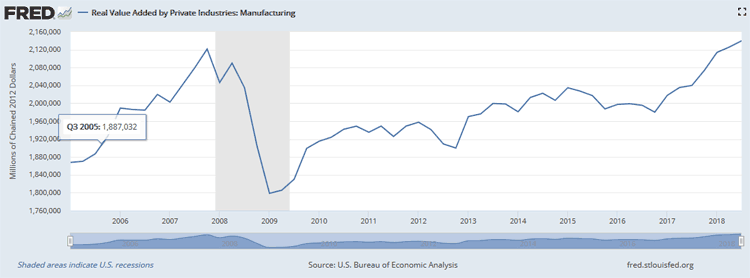If you follow the numbers, there's one thing that is clear with regard to the health of US manufacturing: the data paints conflicting views.
Supply Chain Digest Says... |
|
|
Let's start with the monthly index on US industrial Output from the Federal Reserve Bank.
The broader output index includes production by utilities and mining companies in addition to manufacturing, which makes that measure somewhat volatile, as say a bitter cold January or super hot July can send electricity production soaring.
But the measure also breaks out a separate manufacturing-only index (as well as indices for numerous manufacturing sectors).
That manufacturing index now uses the average month in the year 2012 as its baseline, meaning the index score for that year is equal to 100.
The manufacturing index for the most recent month tallied – February – came in at 104.8. That means that since 2012, US manufacturing output is up just 4.8% - well less than 1% annually.
In fact, the index was mostly flat from 2012 through 2016, hovering around 100, before picking up some growth in 2017 and 2018.
Additionally, the index is still about 5 points below its peak period in 2007.
So how is that flat growth reconciled with data on the US Purchasing Managers Index from the Institute for Supply Management (ISM), which also tracks US manufacturing?
As most know, any score for a month over the 50 mark indicates manufacturing expansion.
As can be seen in the chart below, starting in the second half of 2016, the PMI has been above that 50 mark, and now for about a two-year stretch well above 50. In fact, the index has been positive now with the new March number for 31 consecutive months – seemingly indicating a lot more US manufacturing growth than the Federal Reserve Index.

Then there are measures of US "value-added' in US manufacturing. So, in other words, if components from offshore are assembled in the US, that value-add can be quantified based on the price of the components and the price for the final product.
(See More Below)
As can be seen in the chart below, from the US Bureau of Economic Analysis, US manufacturing value-added, after a sharp rise following the Great Recession, was flattish to down from 2014 through 2016.

But it has risen steadily from there, though perhaps not as much as the chart axes appear to indicate, up about 8% from Q4 2016 to Q3 2018, the last period for which we have data. That value-add was about $2.1 trillion in Q3 2018, as a reference.
Also, this data shows US value-add at last surpassing the 2007 peak in mid-2018.
So is the US manufacturing cup half full or half empty? Seems a little of both.
What's your take on this data and the health of US manufacturing? Let us know your thoughts at the Feedback section below.
Your Comments/Feedback
|